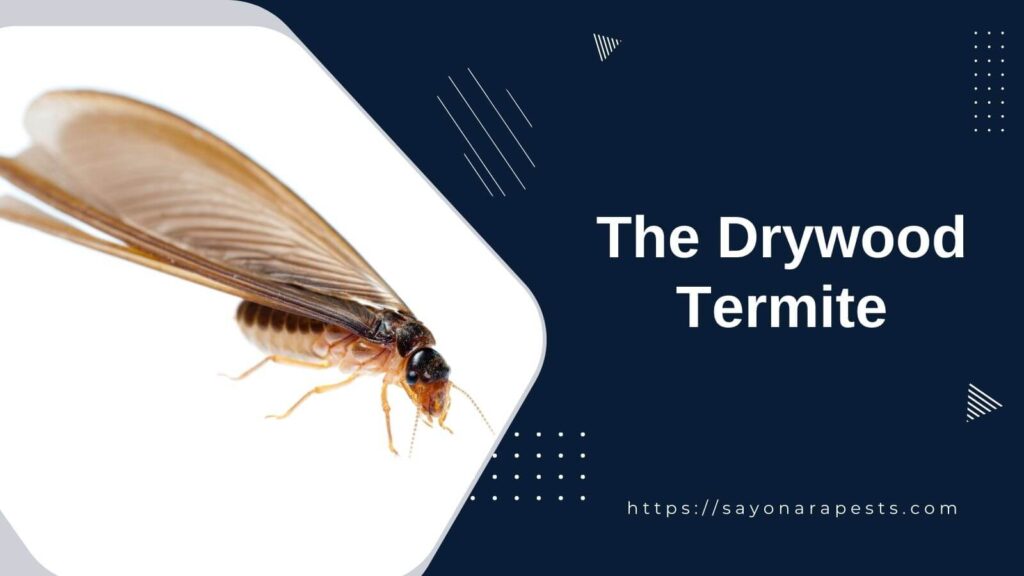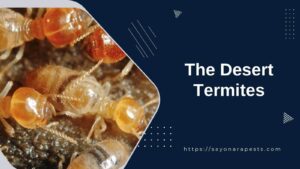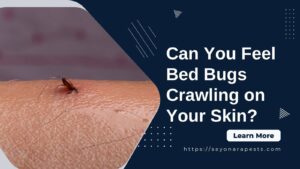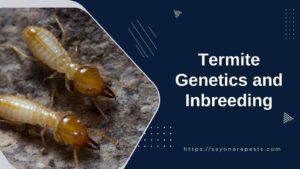Drywood Termites are fascinating creatures that live in the kingdom of insects. They catch the attention of scientists, homeowners, and people who like to get rid of pests.
Drywood Termites have a reputation for being one of the most persistent and tenacious pests because of their ability to get into wooden structures and eat a lot. These scary bugs are known for being able to live and grow only on drywood, which makes them different from their underground counterparts.
Since they can live without soil or water, they can sneak into homes where no one is looking and cause damage.
You can’t say enough about how important it is to get rid of these sneaky invaders. Drywood Termites have an uncanny ability to sneak into homes without being noticed, destroy wooden fixtures, and weaken the structure of buildings.
This can have terrible results, not only in terms of money but also in the safety of the people living there. If these termites aren’t stopped, their ability to cause damage can lead to weaker foundations, beams, and wooden furniture.
By understanding how serious the situation is and how important it is to take effective control measures, people can keep these relentless enemies from entering their living spaces.
As we learn more about Drywood Termites and their complicated lives, their traits, habits, and the urgent need to control their population become clear.
By figuring out how to get through the confusing world of termite infestations, homeowners and professionals can get the knowledge they need to fight these silent destroyers and keep our wooden buildings safe for everyone who lives in them.
Identifying Drywood Termites
Drywood Termites, which are called Cryptotermes spp. by scientists, are exciting creatures with unique physical traits.
These tiny arthropods are known for being able to live in dry places and do well there. This makes them a powerful force when it comes to infestations.
Drywood Termites are only about half an inch long, but they are solid and flexible in a way that sets them apart from their underground cousins. Their bodies are a pale, creamy color, which gives the impression that they are weak.
But underneath their pretty shells is a complicated network of chitinous exoskeletons that were carefully made to help them survive the harsh conditions of their chosen habitats.
Keeping an eye out for Drywood Termites is the best way to find them. These clever bugs leave behind small but telltale signs that can help homeowners and pest control experts find them before they do a lot of damage.
The presence of “termite pellets” or frass is one of the most telling signs. These are tiny, long pellets of feces that Drywood Termites throw out of their nests.
You can often find them all over the areas where they live. The pellets look like coffee grounds or sawdust. They are made when termites eat wood and then get rid of their waste.
In addition to frass, another sign of a drywood termite infestation is the presence of small holes on wood surfaces, about the size of a pinhead. Termites use these holes to get in and out of their nests, which are in the wood.
The holes may be spread out across the infested area, and small piles of pellet-like frass are often found below them.
It is important to remember that these holes may not always be visible because termites often seal them up when they leave. This makes it even harder to find them.
Also, homeowners should look for signs of wings that have been thrown away. When Drywood Termites swarm, they lose their wings and leave them behind while they look for new places to nest.
Termites are attracted to light sources during their reproductive phase, so these wings are usually found near windowsills, light fixtures, or other light sources. If you see these wings, it’s a good sign that there are termites in your home.
Drywood Termites are sneaky, so it is important to keep an eye out for them and act quickly if you see any signs of them.
Professional pest control services are highly recommended if you want to know exactly how bad the problem is and take effective steps to get rid of it.
By knowing how Drywood Termites look and what signs they leave behind, homeowners can protect their homes from the damage they can do.
The Behavior of Drywood Termites
Termites are interesting to study because of the complicated and careful way they build their homes. These scary creatures have a level of architectural skill that is unmatched. They build complicated colonies inside the wood they eat.
A small group of worker termites starts the process by burrowing into the wood and digging out narrow tunnels and chambers that connect to each other. These chambers have different functions, like being nurseries for raising young termites or places to store food and get rid of waste.
Drywood Termites are different from other types of termites because they can build their own societies inside the wood they eat. These societies, which are called “colonies,” are made up of different groups called “castes.”
Each caste has important jobs to do for the survival and growth of the colony. The colonies are set up in a hierarchy, with the queen termite at the top as the only one that can reproduce.
Soldiers protect the colony from outside threats, and workers work hard to take care of the nest’s needs.
Drywood Termites have a very interesting way of building their nests. The termites’ natural ability to find good wood and their skillful use of pheromones to talk to each other help them set up their colonies successfully.
As the nest grows, termite colonies can spread over large areas of the infested wood. This shows how adaptable and resilient termites are by showing how they can build complex and safe homes.
The way Drywood Termites build their nests shows how smart they are and how well they work together
The way Drywood Termites eat gives us a fascinating look at their complicated role in the ecosystem and the processes that lead to wood breaking down.
These hungry animals have evolved to thrive on the cellulose-rich parts of wood, making it easy for them to turn structures that were once solid into food.
But what is both amazing and scary about Drywood Termites is how they eat.
Drywood Termites don’t need to be in direct contact with soil to live, unlike their underground cousins. Instead, they have developed an amazing way to get water out of the wood they eat.
This lets them live in and eat dry, seasoned wood. This change has allowed them to live in many different places, such as buildings, furniture, and even ships.
The worker termites are the first ones to eat when there are Drywood Termites. With their strong jaws, these hardworking insects break up the cellulose in wood into forms that are easier to eat.
The resulting pieces are then eaten and broken down even more by a unique mix of enzymes made in the termite’s digestive system. This makes it easy for the termite to get the nutrients it needs.
The most interesting thing about the way Drywood Termites eat is that they can get food from wood without weakening its structure.
Only eating the softer springwood layers and leaving the harder, denser summerwood gives the impression that the wood is still whole.
This often hides their presence until a lot of damage has already been done. This part of how they eat makes it hard for homeowners and professionals to find and get rid of infestations.
The ways that Drywood Termites build their nests and eat show how clever and flexible nature is. These tiny creatures build complex communities out of the wood they eat, which shows how good they are at building and how well they work together.
Also, the way they eat shows that they can get food from wood without damaging it. This makes them both amazing and hard to get rid of.
Understanding and studying these parts of Drywood Termites’ behavior is important for getting rid of them and keeping our wooden buildings in good shape.
drywood Termite Damage
When it comes to the sneaky world of Drywood Termites, the damage they do to buildings can be nothing short of terrible. These hardy creatures can’t get enough to eat, so they eat away at the foundations of our homes over and over again.
It’s amazing how many different ways these tiny terrors can hurt you. They can do damage that you can see, damage that you can’t see, damage that is open, and damage that is hidden.
Let’s start by looking at how these hungry bugs can hurt our homes. One of the most common signs is the destruction of wooden structures, which happens when Drywood Termites burrow into the heartwood and weaken it.
This sneaky behavior often makes beams that used to be strong and weak, which puts homes and other buildings at risk of falling down. It’s sad to see how these tiny thieves keep destroying the once-proud and tall trees.
But Drywood Termites don’t just damage the things you can see. They also damage the parts of our homes that we can’t see. Behind walls and under floors, these tiny invaders build huge networks of complicated tunnels that hollow out the building’s structure.
The silent decay, which is invisible to the untrained eye, hides the disaster that is about to happen. This is what makes Drywood Termites such dangerous enemies.
They destroy our homes from the inside and don’t leave any visible signs of their presence until it’s too late.
Now, let’s talk about how much it will cost to fix all the damage that these sneaky creatures have done. Unfortunately, bringing our homes back to their former glory costs more than just money. It also takes an emotional and mental toll on us.
Antique furniture with intricate carvings that are now just splinters and cherished memories that time has eaten away. The process of restoring something is a Herculean task that requires not only skilled professionals but also a lot of money.
The cost of fixing damage caused by termites can be too much for homeowners and business owners alike. From buying new materials to hiring skilled workers, the cost of rebuilding quickly goes through the roof and into the stratosphere.
The damage caused by termites has a domino effect that goes beyond the immediate need to fix things. It gets into the very fabric of our lives. It makes us feel less safe and stable and gives us a scary sense of vulnerability.
In the end, Drywood Termites can do a lot of damage and cost a lot of money. In their never-ending search for food, these insects leave no stone unturned. They can be seen breaking down parts of the building, or they can be doing damage behind the walls we trust.
Their sneaky actions hurt us not only financially, but also emotionally. It’s a stark reminder of how fragile our efforts are and a lesson in how powerful even the smallest creatures can be.
drywood Termite Prevention
To stop a Drywood Termite infestation, you have to pay close attention to every detail and use a multifaceted approach that includes preventative measures and smart home maintenance.
Before starting a journey of prevention, you need to know all the steps you need to take to keep these small but dangerous enemies away.
By using a series of techniques designed to reduce the chance of Drywood Termite infestations, homeowners can protect the structural integrity of their homes and keep their living spaces clean and safe.
First and foremost, it’s important to know the main ways that these persistent termites get into homes. Cracks and crevices in foundations, walls, and roofs allow these hungry pests to get into homes.
To protect the citadel of your home, it is of the utmost importance to carefully check and seal these weak entry points. A trained eye is needed to check all the cracks and crevices that could let termites in because even a small mistake can lead to a full-blown infestation.
A smart homeowner should also know how important it is to keep up with home maintenance if they want to keep Drywood Termites away. A good defense strategy is built on careful maintenance and regular inspections.
Checking the wood in your home, such as window frames, doors, and furniture, on a regular basis can help you find signs of termite activity early on. When caught early, these sneaky creatures can be dealt with quickly and effectively.
Homeowners can use targeted treatments or, in some cases, hire a professional to get rid of the threat they pose.
At the same time, it’s important to take preventative measures to stop Drywood Termites from spreading. Using materials that are resistant to termites when building or fixing up your home is a great long-term investment in keeping it in good shape.
These specially made materials act as a deterrent, making the area uncomfortable for the termites and stopping them from doing damage that can’t be fixed.
Also, using chemically treated wood, which has properties that make it hard for termites to live there, is a good way to keep them away and greatly reduce the chance of an infestation.
In addition to these measures, it’s important to keep the environment in a way that keeps termites away.
By clearing away trash and plants near the house on a regular basis, these bugs will be less likely to gather and set up colonies near where people live.
Drywood Termites can be stopped from living by making sure there is enough airflow and moisture control.
These pests like to live in damp, poorly ventilated places. Installing proper drainage systems, fixing pipes that leak, and making sure there is enough ventilation can all make it hard for termites to live there, lowering the risk of an infestation.
Preventing Drywood Termite infestations requires a multifaceted approach that includes careful home maintenance, preventative steps, and a thorough understanding of how these dangerous pests work.
Homeowners can build an impregnable fortress against these sneaky invaders by strengthening the physical barriers of their homes, getting regular inspections, and using materials that are resistant to termites.
You can’t say enough about how important preventive measures are because they are what keep the structure of your home in good shape and make it a safe place to live.
Natural Predators of Drywood Termites
When you go on a trip into the wild world of Drywood Termite predators, you’ll meet a lot of scary creatures whose very existence is a biological answer to the termite problem.
The Lizard, which is known for being quick and good at hunting, is the most dangerous of these fierce hunters. With their long, sharp tongues and sharp, serrated teeth, these quick reptiles can grab termites from their temporary homes in a flash, leaving a trail of destruction in their wake.
Ants are very brave because they fight Drywood Termites without giving up. They do this to make sure that they will be able to stay alive.
Armed with a large army of workers, these hardworking invertebrates sneak into termite colonies and use their jaws and acidic secretions to destroy the termite empire from the ground up.
Their huge numbers and unwavering determination help tip the scales in favor of keeping the delicate ecosystem in balance.
In the mysterious twilight of the natural world, the awe-inspiring Bat shows up as a powerful opponent to the Drywood Termite threat. These nighttime hunters have amazing flying skills and use echolocation to find their way around in the dark.
Under the cover of night, they swoop down on termites that don’t see them coming. As they catch their prey in midair, their leathery wings make a beautiful sound. With each successful hunt, the bat’s huge appetite helps keep the number of termites under control.
Even though each predator works in its own unique niche, they all have the same goal: to keep the balance when Drywood Termites keep moving forward.
As they do their jobs as predators, these natural attackers offer a glimmer of hope to homeowners and the wooden structures that are being destroyed by the insects’ voracious appetites.
The presence of natural predators in the complex world of the Drywood Termite is not just a coincidence; it is a well-planned event that keeps the checks and balances that are needed for the survival of all species involved.
Drywood Termite populations can be controlled not just by people or chemicals, but also by the complex web of relationships that exist in the natural world.
By eating Drywood Termites, these natural killers help keep the environment stable by stopping unchecked population growth and keeping the structural integrity of wooden habitats. Their presence shows how closely all living things are connected.
It also shows how delicate the relationship between predators and prey is in the grand symphony of life.
In a world with more and more environmental problems, learning about and using the power of natural predators could be a sustainable and all-around way to reduce the damage done by Drywood Termites.
By appreciating the many different ways this relationship between predator and prey is beautiful, we can start on a path that celebrates the wonders of nature while living in harmony with the animals that live there.
Risks to Health
Termites might not be the first thing that comes to mind when you think of things that could be bad for your health. But even though these bugs don’t seem dangerous, they do pose some health risks.
To fully understand how dangerous these risks are, it’s important to look into the complex web of interconnected factors that add up to the overall health risks of Drywood Termites.
First of all, it’s important to realize that the biggest danger these insects pose is to the structural integrity of homes and buildings. Drywood Termites can’t get enough of things made of cellulose, which includes wooden structures.
As they quietly eat their way through walls, floors, and furniture, they make those places less stable. When structures get weaker, they can cause everything from small accidents like falls and injuries to big disasters like ceilings or whole sections of a building falling down.
So, the health risks linked to Drywood Termites go beyond physical health and include the possibility of things that could change the rest of your life.
In addition to the direct damage they do to the structure, Drywood Termites indirectly put people’s health at risk because they can make places where mold can grow.
When these sneaky bugs burrow into wet wood, they make tiny holes and tunnels. Mold loves damp places, so these hidden places are the perfect places for it to grow.
Mold is well-known for being bad for people’s health. It sends out spores into the air that can cause allergies, asthma attacks, and other breathing problems.
Mold spores can cause long-term health problems, especially in people who already have breathing problems or immune systems that aren’t as strong.
So, having Drywood Termites around indirectly raises the risk of getting respiratory problems and makes existing health problems worse.
When talking about how to get rid of termites without putting people’s health at risk, it is important to use an approach that is both effective and safe.
Traditional ways to get rid of termites, like fumigation or spraying pesticides, can be dangerous to people’s health if they aren’t done carefully.
The chemicals used in these processes can be dangerous and give off fumes that can irritate your lungs or even kill you if you eat them or let them soak into your skin.
So, it is very important to hire professional pest control experts who have the skills and knowledge to take the right safety measures during the process of getting rid of termites.
Also, other methods like heat treatments or targeted localized treatments can be looked into because they are better for the environment and pose less risk to health.
Also, preventive measures are a big part of reducing the health risks that come with Drywood Termites. Regular inspections and maintenance of wooden buildings can help find termite infestations early and stop them from causing a lot of damage and health problems.
Also, making sure there is enough ventilation and moisture control in the building can discourage termite activity by making it hard for them to stay alive. By taking these preventative steps, people can protect their health and reduce the risks that these wood-eating pests pose.
Drywood Termites, even though they are small, can be very dangerous to people’s health. In addition to being a direct threat to the stability of the building, these insects indirectly cause health problems by making mold grow.
But people can reduce these health risks by using an integrated approach to get rid of termites, getting help from a professional, using safer treatment methods, and taking preventive steps.
People and communities that have Drywood Termites need to be aware of the problem and take action to protect their physical health and long-term health.
In the end, it’s important to point out the most important things that have been said about preventing and getting rid of Drywood Termites. You can’t say enough about how dangerous these sneaky bugs are.
They can cause a lot of damage to our homes and buildings by quietly eating away at the very foundations of our homes. So, it’s important for both homeowners and people who own other properties to keep an eye out for these pests that eat a lot.
In this article, we’ve talked about different things you can do to stop Drywood Termites from getting into your home.
From carefully checking wooden structures to taking preventative steps like sealing cracks and crevices, we have looked into a wide range of things that can be done to stop these hardy creatures from taking over.
Also, we have stressed how important it is to find and get rid of termite colonies as soon as possible, as well as the role of professional pest control services in this regard.
Still, even though we know a lot about Drywood Termites and have a lot of tools to keep them away, it is very important to stress how important it is to always be on the lookout for them.
Even though we might want to let out a sigh of relief when we stop these sneaky invaders, we can’t let our sense of security cloud our judgment.
Termites are very adaptable creatures that can find new ways in and take advantage of weaknesses in our defenses.
So, we must always be aware and ready to protect our properties and lessen the damage that these pests can do.
By sticking to our plans to prevent and get rid of Drywood Termites, we are not only protecting the structural integrity of our homes but also the large investments we have made.
Infestations of termites can cost a lot of money because repairs and renovations often cost a lot of money.
So, it is much smarter and cheaper to put our efforts into making our defenses stronger and stopping infestations before they start.
In conclusion, the fight against Drywood Termites is an ongoing fight that needs our full attention at all times. With vigilance, education, and the right preventive measures, we can keep these harmful insects from destroying our property.
Let’s not underestimate how dangerous Drywood Termites are or how much our knowledge and actions can help keep them away.
You can’t say enough about how important it is to stay alert when trying to stop and get rid of Drywood Termites.
Together, we can make a place where these silent invaders can’t live and protect the sanctity of our homes for future generations.











